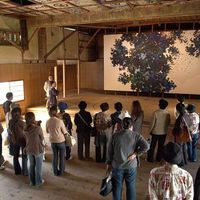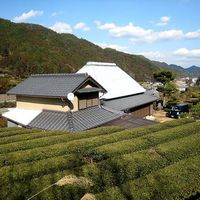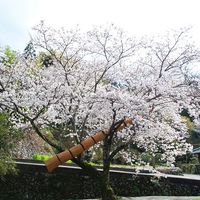Revitalising Rural Communities through the Arts | Kamiyama Art Residency Shikoku, Japan

As part of culture360's ongoing Call for articles 2023, Cléo Verstrepen explores the social value of rural art organisation, Kamiyama Art Residency (KAIR), and its role in rural revitalisation and socially sustainable development of the local communities in Japan post-Covid-19.
As Japan faces one of the most severe demographic crises in the world, rural art organisations are attracting growing attention as potential channels for revitalising the countryside. While massive flagship projects like the Naoshima-Teshima Complex or Echigo-Tsumari Art Field are often touted as successes, criticism about their disconnection, or even contradiction, with the local communities' concerns are growing (Zernik, 2017, Koizumi, 2018, Qu 2019). Away from the media's attention, smaller-scale, community-led projects could offer an alternative response to this issue. A prime example comes from Kamiyama Art Residence (KAIR), implemented in Shikoku in 1999 by a group of volunteer inhabitants. Using art as a catalyst, they managed to regenerate local life in just a few years, defying the government's predictions to the point that in-migration in Kamiyama surpassed out-migration for the first time in history in 2011 (Yoshimoto, 2018). To uncover the dynamics behind this success, I visited Kamiya Art Residence in September 2022 and met the organisers, local inhabitants, and visitors.
Direct involvement of the local community
"The thing we value most is not so much the kind of work, but the fact that the villagers can connect with the artists and make them be part of the community" explains founding member Masaki Mori.
The particularity of KAIR is that whether it is selecting artists or realising artworks, the community is involved in every step of the way. Despite modest facilities and fees, KAIR provides artists with other valuable resources, most importantly, the support of the local community. During their three-month stay, residents organise events, workshops, and a final exhibition, whereby they showcase their work throughout the city in rehabilitated indoor and outdoor spaces. I identified 4 main characteristics of the works created, which often overlap: the preservation or the reinterpretation of the local memory based on archive work or testimonials, the use of local techniques and crafts in collaboration with local craftspersons, the creation or the renewal of spaces through site-specific processes, and co-creation with the direct participation of the inhabitants.
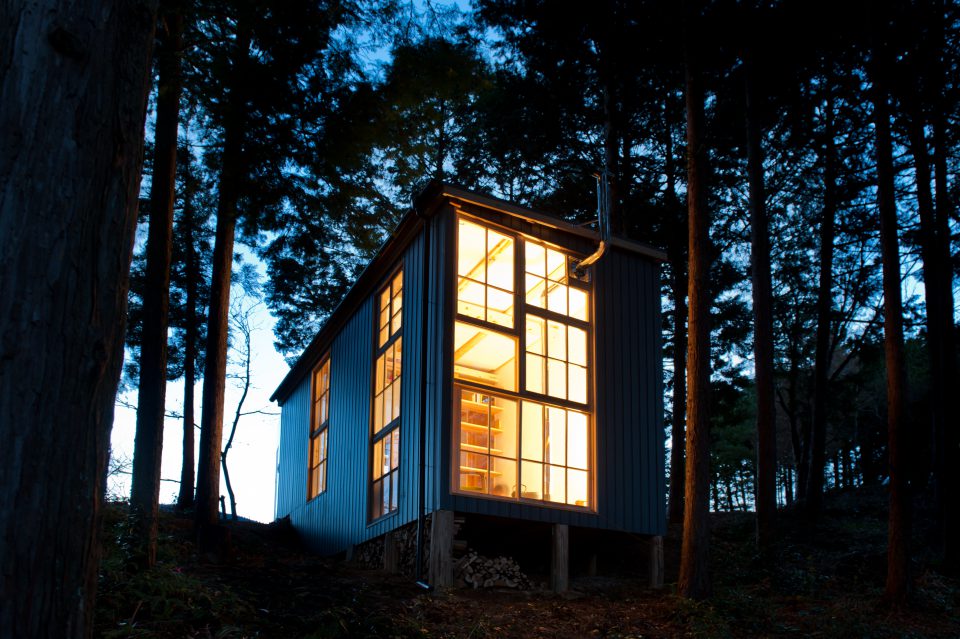
1. Artist-in-residence Hideaki Idetsuki's Hidden library, 2012© KAIR
Art as a key ingredient in a larger social programme
What also makes KAIR unique is that after a few years of realising that creative activities were attracting a new, young population, the organisers decided to expand beyond the residency by creating a non-profit organisation (NPO) called Green Valley. In addition to running the residency programme, Green Valley has set up a support system for people wishing to settle on a long-term basis, helping them find a space and resources for their project, with a focus on activities with a positive social and economic impact, such as IT companies, design studios, a training course in local development, or a sustainable food hub. This innovative model of cultural management, in which art activities are inserted into a larger programme, allows art to keep some independence from the social context without disconnecting from it. Reciprocally, social issues gain from being approached critically and publicly through the lens of art yet are also tackled with adapted means that art alone could not provide.
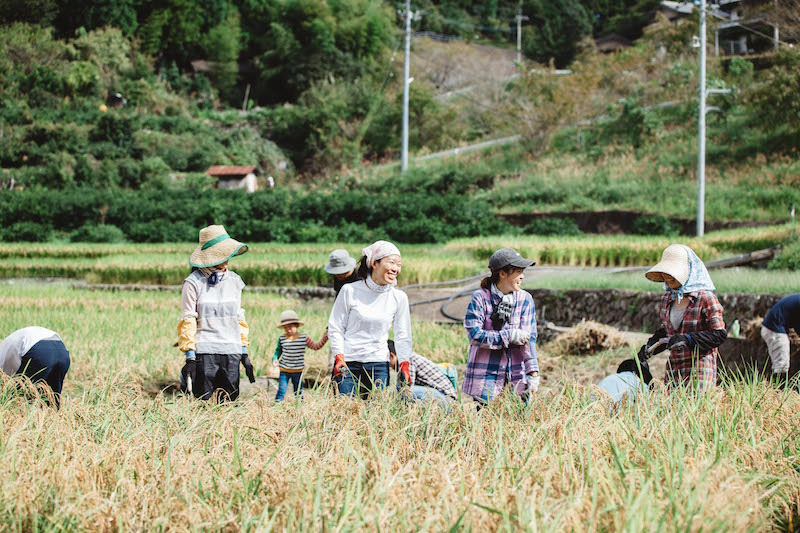
2. Kamiya's Food Hub project, 2016 © Food Hub
Developing a balanced global-local culture
In addition to many foreign visitors, Kamiyama now counts among its population very mixed inhabitants. In rural art projects, disparities often emerge between the contemporary global culture and small communities' traditions (Qu, 2019) but from the beginning of the project, KAIR staff paid attention to facilitating a dialogue between them. According to the founders, the town’s tradition of hospitality, as a stage of the Shikoku Pilgrimage, and a ten-year cultural exchange programme with English teachers had already “prepared” the population for the implementation of the project. Then, art activities provided the chance for the community to gather and nourish a common sense of place while also mixing with international people. As a virtuous circle, sharing their culture with the artists strengthened the bonds between inhabitants, and the artists’ views on their town renewed the image they had of it.
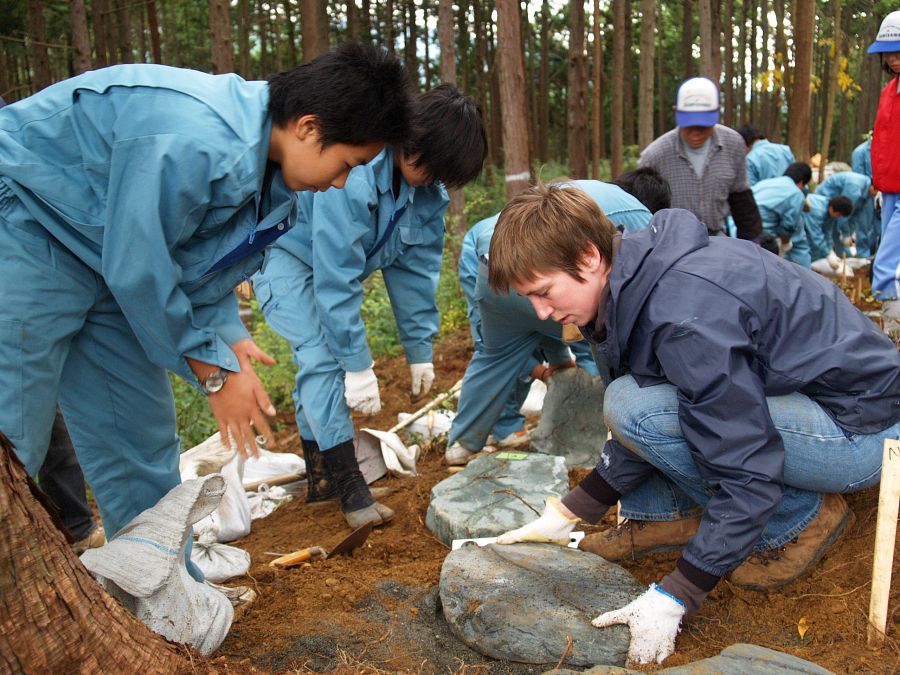
3. Collaborative making with the inhabitants of Vaughn Bell's Becoming a river project, 2007 © KAIR
Valuing living over tourism
In addition, the countryside here is not valued as a tourism destination, but as a place to live. “You don’t leave with an exhibition catalogue or a postcard, but with the desire to come back one day and create your own creative project,” says Y., a visitor in her twenties. Although communities are threatened in rural areas, social ties between individuals appear stronger than in metropolitan regions where individualistic lifestyles prevail. In Kamiyama, this traditional social life is perceived as a heritage to preserve, as well as something to expand and renew. For newcomers, it acts as a remedy to the anomie of the city:
"In Tokyo, lots of people are movie directors, but here I am considered special, I have my own role. If I had stayed in Tokyo, I would never have become an artist." says M, an inhabitant.
At a time when 80% of 'I-turn' migrants in Japan, are adults in their 20s and 30s who migrate from urban to rural areas, looking for a more meaningful life and cultural activities (Klien, 2020), finding ways to make villages more attractive to them is key. Green Valley acts as a mediator in this process, helping to introduce fresh ideas into the village's life.

4. Artist-in-residence Mutsumi Uchiyama’s Flag Project workshop, 2005 © KAIR
Promoting quality over quantity
The projects’ small scale also plays an important role. As related by Yoshimoto (2018), “They didn’t jump into a large-scale project from the beginning: the accumulation of activities (...…) is what led to their present achievements”. The absence of any major private or public investment meant less pressure on results, allowing the NPO to progress at its own pace and maintain a subtle approach to relations with locals. Along these lines, the concept of "creative depopulation", coined by Mori is a great tool for thinking about the role of art in a revitalisation process: "Accepting the reality of depopulation; not trying to change it in absolute numbers but in its content. Aiming for a balanced, sustainable, local community that reduces its dependence on farming by attracting young, creative, talented people from outside to create a healthy population composition (...).” (Cited in. Yoshimoto, 2018).
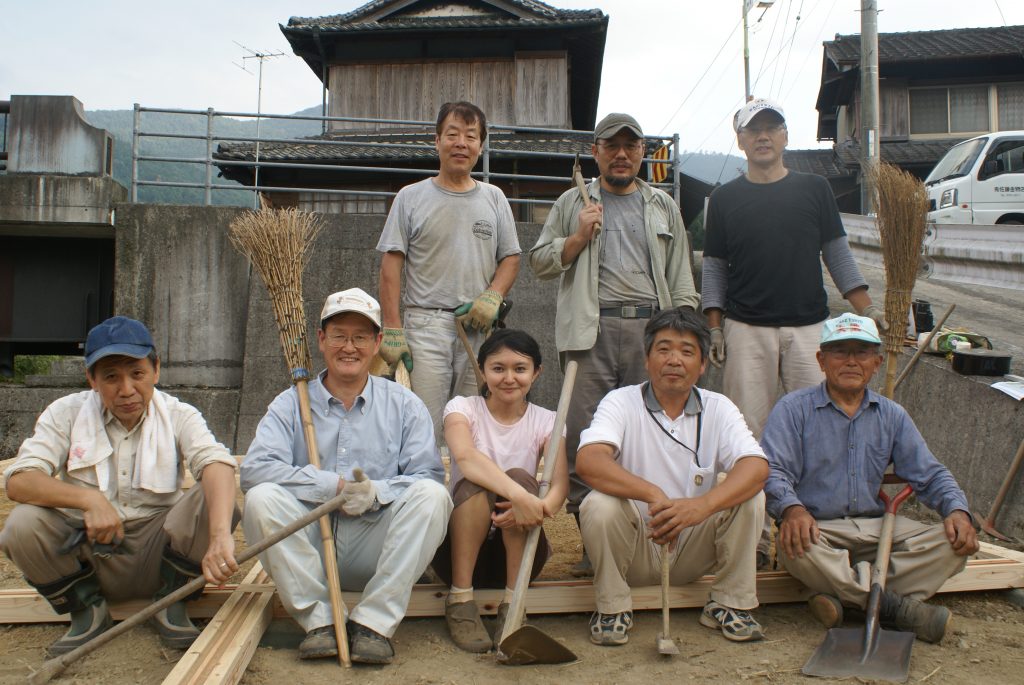
5. Construction of artist-in-residence Yuki Hori's Home Garden, with the help of local inhabitants, 2010 © KAIR
Conclusion
While artistic activities alone may not be enough to resolve complex issues like demographic decline, they play a vital role in raising awareness of the problem among the communities, enabling critical engagement, and fostering creative solutions. The residency in itself did not change Kamiyama’s social destiny, but it created a favourable ground for other initiatives to grow and catalysed a new dynamic. Rather than solely focusing on concrete results, it is essential to recognise the intangible effects of art projects, which are necessary ingredients for sustainable changes. Therefore as policymakers and researchers, we must highlight the importance of a qualitative approach that allows for personal narratives, emotions, and subjectivities to emerge.
Cover Image: Kamiya's Food Hub project, 2016 © Food Hub
References
1. Kawashima, Nobuko. The Development of Art Projects in Japan: Policy and Economic Perspectives, FIELD - A Journal Of Socially-Engaged Art Criticism, Issue no.8, 2017.
2. Klien, Susanne. Urban Migrants in Rural Japan: Between Agency and Anomie in a Post-Growth Society. SUNY Press, State University of New York Press, 2020.
3. Koizumi, Motohiro. 7. ‘Connecting with Society and People through ‘Art Projects’ in an Era of Personalization.’ in Cities in Asia by and for the People (pp.177-200), dir. Cabannes, Yves et al. Amsterdam University Press, 2018.
4. Machotka, Ewa. ‘The Geopolitics of Ecological Art: Contemporary Art Projects in Japan and South Korea’. Mutual Images Journal, no. 5, Dec. 2018, pp. 105–22. DOI.org (Crossref), https://doi.org/10.32926/2018.5.mac.geopo.
5. Obikwelu, Faith E., et al. ‘The Roles of I-Turn Migrants in Revitalizing Rural Communities: A Case Study of Some Selected Rural Areas in Kansai Region’. Journal of Rural Problems, vol. 54, no. 3, Sept. 2018, pp. 125–32. DOI.org (Crossref), https://doi.org/10.7310/arfe.54.125.
6. Qu, Meng. ‘Art Interventions on Japanese Islands: The Promise and Pitfalls of Artistic Interpretations of Community’. The International Journal of Social, Political and Community Agendas in the Arts, vol. 14, no. 3, 2019, pp. 19–38. DOI.org (Crossref), https://doi.org/10.18848/2326-9960/CGP/v14i03/19-38.
7. Qu, Meng. “The Influence of Setouchi Triennale's Rural Art Festival Tourism on the Revitalization of Islands in the Seto Inland”. PhD diss, Hiroshima University, Graduate School of Integrated Arts and Sciences, 2021.
8. Tomoe, Atsushi. ‘Aging Kamiyama Hopes to Rejuvenate with IT Startups’. The Japan Times, 1 Jan. 2014, https://www.japantimes.co.jp/news/2014/01/01/business/aging-kamiyama-hopes-to-rejuvenate-with-it-startups/.
9. Yoshimoto, Mitsuhiro. Kamiyama’s Success in Creative Depopulation. FIELD - A Journal Of Socially-Engaged Art Criticism, Issue no.8, 2017.
10. Zernik, Clélia. ‘L’Art Japonais Après Fukushima : Au Prisme Des Festivals’. Critique d’art, no. 49, Nov. 2017, pp. 85–104. DOI.org (Crossref), https://doi.org/10.4000/critiquedart.27147.
About the Author
Cléo Verstrepen is a Ph.D. student at the University of Vincennes Saint-Denis (Paris 8) and at the Tokyo University of the arts, as a recipient of the Japanese Government (MEXT) Scholarship. Their interdisciplinary thesis focuses on community-led art organisations involved in urban or rural revitalization and community empowerment processes in Japan. Cléo Verstrepen’s approach to research is creative and integrative, spreading outside the academic sphere through artistic and curatorial practices, as well as writing and translation. Since 2022, they are running the collective project space Datsuijo in Tokyo.
Similar content
deadline
20 Mar 2018
deadline
28 Feb 2020
deadline
20 Feb 2019
deadline
28 Feb 2015
deadline
15 Feb 2013
deadline
25 Mar 2019



